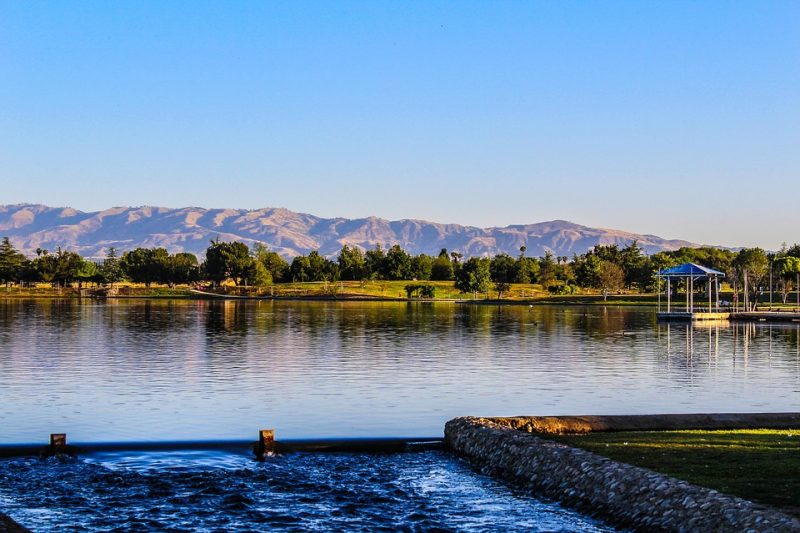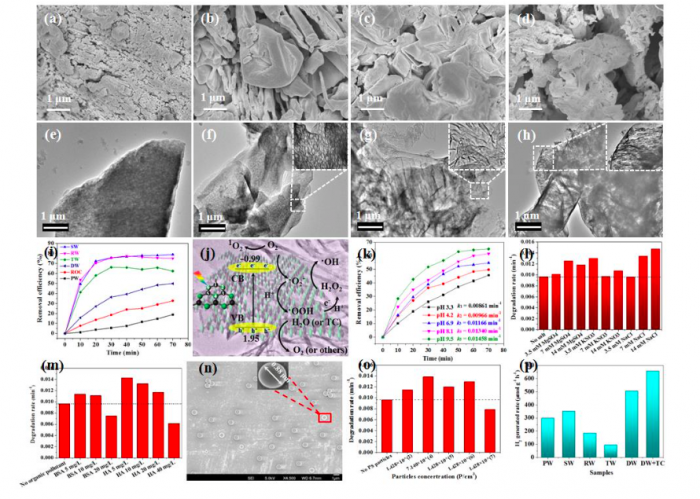
Both water and energy are key sustainability issues that need to be addressed. To this end, photocatalysis is advantageous not only for expediting environmental remediation but also for energy generation.
However, the development of novel functional materials and the lack of understanding of the influences in the photocatalytic reaction are still key technical barriers impeding the commercialization of photocatalytic technology.

MacRitchie reservoir park in Singapore (left) and straits of Singapore (right). Credit: Hou Wang
Three dimensional (3D) carbon nitride structures achieve longer-range orders between individual carbon nitride sheets compared with bulk carbon nitride and have more space for mass transportation or storage for electron/ion, gas, and liquid. Such superior structure characteristics endow favorable light-trapping and efficient separation of charge carrier during the photocatalytic process. Therefore, constructing 3D carbon nitride with an ordered porous structure for the removal of antibiotics in water is promising.
In practical applications, the photocatalytic elimination efficiency of contaminants can be significantly affected by natural water constituents ubiquitously present in water, because of the formation and consumption of strongly-oxidized radicals, the change in the physical-chemical properties of the photocatalyst, and the preferential reaction. In parallel, green energy production (like H2) from wastewater, which is also a capability of the photocatalysts, further addresses the sustainability issue.
To bridge the gap between fundamental understanding and practical application, in a study by How Wang, Yan Wu, and Jia Wei Chew, a polymeric carbon nitride foam (CNF) was constructed via a sugar-blowing approach using ammonium chloride as the bubbling agent for the removal of tetracycline (TC-HCl) antibiotics and energy reclamation from natural water matrices and wastewater in real water matrices (Figure 1). Compared with artificial wastewater, higher degradation efficiencies of TC-HCl were observed in tap water, real seawater, real reservoir water, but lower efficiencies in pharmaceutical wastewater and reverse osmosis concentrate. Various factors including solution pH, ions species and organics (humic acid and bovine serum albumin) played a vital role in the overall performance of the catalyst.

Figure 1. FESEM and TEM images of (a, e) GCN, (b, f) CNF-1, (c, g) CNF-4 and (d, h) CNF-2. (i) Effect of different water matrices on the removal of TC by CNF-4. (PW: Pharmaceutical wastewater; ROC: Reverse osmosis concentrate; SW: Real seawater; RW: Real reservoir water; TW: Tap water; DW: deionized water). (j) illustration of energy conversion, electron flow and radical species evolution. (k) The effect of pH on the removal of TC by CNF-4. (l) Effect of different salt species and concentrations on the removal of TC by CNF-4. (m) Effect of BSA and HA on the removal of TC by CNF-4. (n) SEM image of polystyrene (PS) particles and (o) effect of PS particles on the degradation of TC by CNF-4. (p) Visible-light photocatalytic H2 evolution by CNF-4 from different water matrices. Republished with permission from Elsevier from https://doi.org/10.1016/j.watres.2018.07.025
The presence of microplastics at various concentrations also affected the photocatalytic removal of TC-HCl. The C-N-C moiety of TC-HCl was the initially reactive site for strongly oxidizing radical attack. Hydrogen energy was photocatalytically reclaimed from natural water matrices and wastewater with simultaneous water purification. Moreover, to further improve the photocatalytic performance, the calcination temperature in the presence of NH4Cl can be optimized, with CNF-4 (calcined at 550 °C) shown to have degradation efficiencies 1.84, 2.49 and 7.47 times than that of CNF-2 (600 °C), CNF-1 (500 °C) and GCN (without NH4Cl), respectively.
This work encompasses novel nonmetal photocatalyst synthesis for both environmental remediation and clean energy production, explanation of the underlying mechanisms through experimental characterization and mathematical modeling, and also an experimental investigation of the dominant factors influencing the photocatalytic performance in real water matrices.
These findings are described in the article entitled Visible-light-driven removal of tetracycline antibiotics and reclamation of hydrogen energy from natural water matrices and wastewater by polymeric carbon nitride foam, recently published in the journal Water Research. This work was conducted by Hou Wang, Yan Wu, Wenguang Tu, Tong Xiao, Huixiang Ang, Jia Wei Chew from the Nanyang Technological University in Singapore, Ting Xiong and Xingzhong Yuan from the Hunan University in China, and Mingbao Feng from Texas A&M University in the USA.
Reference:
- Hou Wang, Yan Wu, Mingbao Feng, Wenguang Tu, Tong Xiao, Yue Liu, Huixiang Ang, Xingzhong Yuan, Jia Wei Chew. Visible-light-driven removal of tetracycline antibiotics and reclamation of hydrogen energy from natural water matrices and wastewater by polymeric carbon nitride foam. Water Research, 2018, 144, 215-225. https://doi.org/10.1016/j.watres.2018.07.025.









